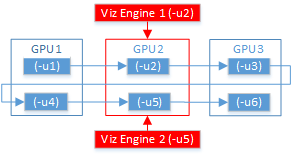
Viz Engine Administrator Guide
Version 5.0 | Published December 20, 2022 ©
Viz Command Line Options
You can start Viz Artist and Viz Engine with various startup options. These command line parameters must be passed to the Viz executable file, viz.exe. The batch file viz.cmd is only there for compatibility reasons. The table below details the most common Viz Command Line Options. You can get a list of all available startup options, by running viz.exe -h or -? from the command line.
Important Change From Viz Engine 4: Starting with Viz Engine version 5.0, the parsing is done according to the POSIX standard with GNU extensions. The most notable change is the space between the option character and the option argument if the option requires an argument and the required long option form for Graphic Hub parameters: --db instead of -db.
|
Command |
Description |
|
-B <path> |
Specify the path where Viz Engine stores its temporary data (see Viz Engine Folders). |
|
-c |
Start in Viz Configuration mode (see also -u 1, -u 2, -u 3). |
|
-C |
Start without a console. |
|
--db user:pw@server/name-server:port |
Specify which Graphic Hub to connect to on Viz Engine startup. password can be omitted from the argument, but user, server, name-server and port must always be provided. Example: viz.exe --db Guest:@VizDbServer/localhost:19396 In the example above, Viz Engine connects to a Graphic Hub server called VizDbServer ( |
|
-g <config file> |
Start with a predefined Viz Config file. This allows a User to have more than one startup option. |
|
-G 1, -G 2, -G n |
Sets the GPU affinity for the selected instance. For systems with two or more graphic cards (Viz Trio One Box / Dual Channel). See Systems with Two or More GPUs below. Example: viz.exe -u 1 -y -n -G 1 starts Viz Engine with On Air GUI as first instance, bound to the first GPU. viz.exe -u 1 -y -n -G 2 starts Viz Engine with On Air GUI as first instance, bound to the second GPU. |
|
-h, -? |
Display the available commands. |
|
-i |
Enable pre-initialization of textures. Textures are generated on the graphics card immediately after loading an image. |
|
-l |
Specify a console title to distinguish Viz Engines in a Dual Channel setup (example: -l <title>). |
|
-M |
Used by Viz Trio to allow sharing of content between Viz Artist and Viz Trio. |
|
-n |
Start in Viz Engine mode (see also -u 1, -u 2, -u 3). |
|
-o "<scene>" |
There is also an optional argument may give a scene that is loaded upon startup with the following syntax: |
|
-P |
Disable automatic mouse capture. |
|
-t |
Enables non-interactive mode for all occurrences except dongle issues and sound driver setup. The non interactive mode was introduced for use cases where there is no user and when there is no GUI one can interact with. |
|
-T |
Keep the Viz Engine Console always on top. |
|
-u 1, -u 2, -u 3 (up to a maximum of 24) |
Sets the instance number. |
|
-v [argument] |
Enable verbose mode. This enables all possible information to be shown in the Viz Engine Console. The optional argument is a number composed by addition of: |
|
-w |
Start in Engine mode and show render window (videowall mode). |
|
-W |
Disable restart on crash. |
|
-X |
Write extended dump file (full memory dump) in case of a program crash. |
|
-y |
Start in Artist mode. Viz Artist is stated by Viz Engine after the Engine has started. |
|
-Y <path> |
Specify the path where Viz Engine stores its program data (see Viz Engine Folders). |
Systems with Two or More GPUs
It is possible to specify which GPU Viz Engine should run on, by providing the flags -G n, whereas n means the index of the GPU (starting with 1). In combination with the -u flag, it is possible to start Viz on a dedicated GPU, no matter, where the primary monitor is connected to.
Providing the -G parameter is mainly used to bind certain instances to dedicated GPUs or to make sure, that a GPU is not occupied by any Viz Engine instance.
Example:
viz.exe -u 1 -y -n -G 1 starts Viz Engine with On Air GUI as first instance, bound to the first GPU.
viz.exe -u 2 -n -G 2 starts Viz Engine as second instance with console only, rendering on the second GPU.
viz.exe -u 2 -n -G 1 starts Viz Engine as second instance with console only, but rendering on the first GPU.
If only the -u parameters are provided, Viz uses the old behavior by automatically assigning the GPU to the instance started.
Formula: m%n, where:
-
m = -u 1/-u 2/etc.
-
n = number of GPUs
For example, with two Viz Engines:
-
System with two GPUs: Engines run on GPU2: Engine 1 (-u 2) / Engine 2 (-u 4)
-
System with three GPUs: Engines run on GPU2: Engine 1 (-u 2) / Engine 2 (-u 5)

When either Viz Trio One Box or Dual Channel Viz Artist versions are installed, GPUs are selected by default.